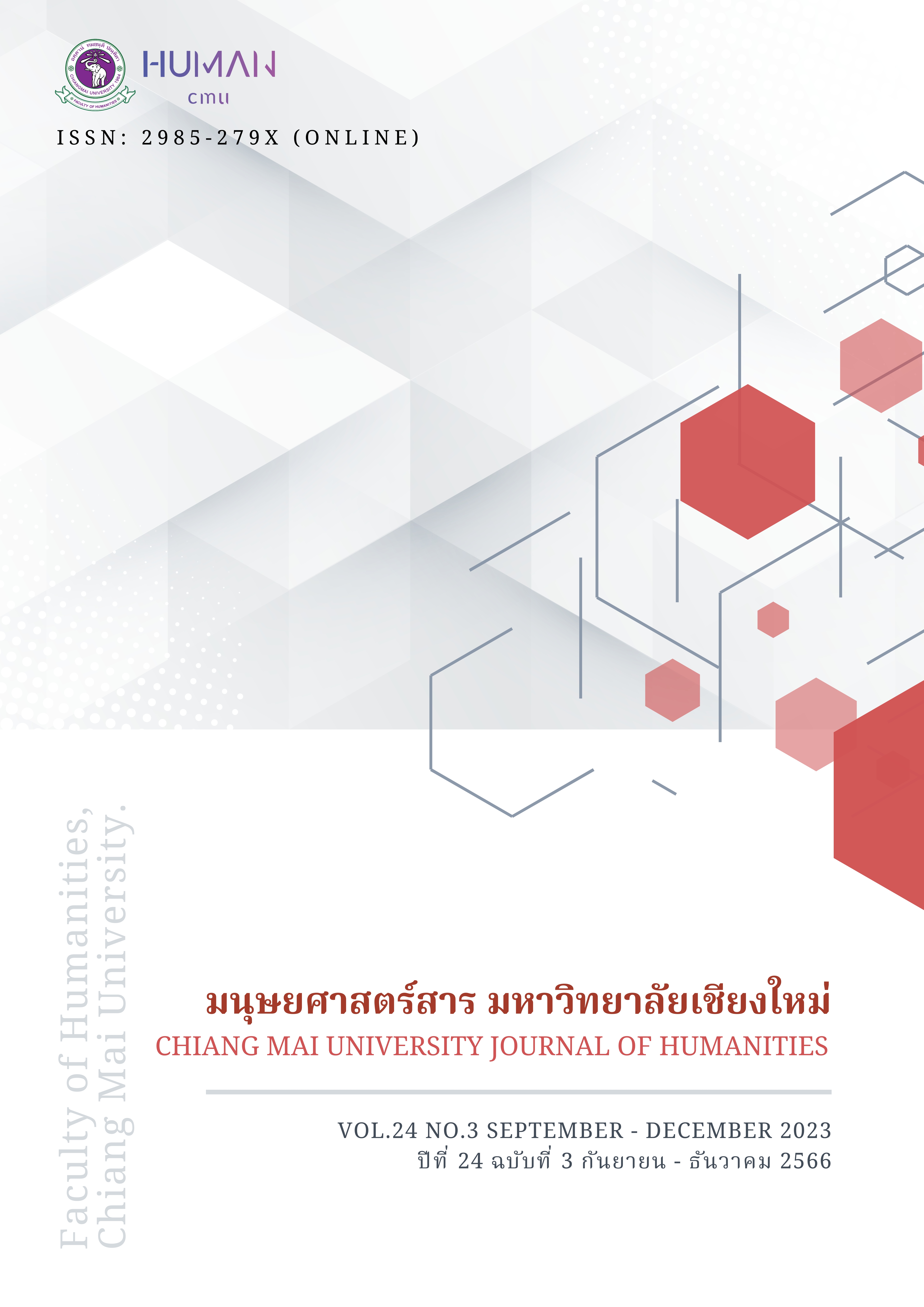ศาสนศรัทธาและศาสนปฏิบัติของหญิงบริการ จังหวัดเชียงใหม่
Main Article Content
บทคัดย่อ
บทความนี้เป็นงานวิจัยเชิงชาติพันธุ์ว่าด้วยศาสนศรัทธาและศาสนปฏิบัติของหญิงบริการ มีวัตถุประสงค์เพื่อศึกษาการปะทะสังสรรค์ระหว่างวัฒนธรรมกระแสหลัก (great tradition) นั่นคือพุทธศาสนา และกระแสรอง (little tradition) นั่นคือแนวความเชื่อและปฏิบัติท้องถิ่นหรือศาสนาผี โดยศึกษาผ่านรูปแบบความเชื่อ วิถีปฏิบัติ และประสบการณ์ทางศาสนาของหญิงบริการในจังหวัดเชียงใหม่ การศึกษาที่ผ่านมาเสนอว่าความสัมพันธ์ของสองวัฒนธรรมนี้มักเป็นไปในลักษณะจากบนลงล่างหรือล่างขึ้นบน นั่นคือวัฒนธรรมกระแสหลักกลายกลืนวัฒนธรรมกระแสรองโดยเฉพาะในกลุ่มชนชั้นล่าง ดังจะเห็นได้ในกระบวนการกลายเป็นเช่นชนชั้นสูง (พราหมณ์) (Sanskritisation) ในอินเดีย ทั้งนี้ การศึกษาประสบการณ์ทางศาสนาของหญิงบริการในจังหวัดเชียงใหม่จำนวน 29 คน สะท้อนให้เห็นถึงการปะทะสังสรรค์กันของวัฒนธรรมกระแสหลักและวัฒนธรรมกระแสรองในรูปแบบที่แตกต่างจากกระบวนการกลายเป็นเช่นชนชั้นสูง(พราหมณ์) ศาสนาผีมีอิทธิพลต่อการประกอบอาชีพและการดำรงชีวิตของหญิงเหล่านั้นเป็นอย่างมาก หญิงบริการยังมีการนำเอาความเชื่อและแนวปฏิบัติศาสนาแบบท้องถิ่นมาใช้เป็นแนวทางในการดำเนินชีวิต สร้างบุญบารมีและเสริมมงคลเพื่อประโยชน์ทั้งทางตรงและทางอ้อมต่ออาชีพสถานะทางการเงินและทางสังคมของตน การศึกษานี้สะท้อนให้เห็นว่าวัฒนธรรมกระแสรอง (ศาสนาผี) ได้ครอบครองพื้นที่ศักดิ์สิทธิ์ในผู้คนมากกว่าวัฒนธรรมกระแสหลัก (ศาสนาพุทธ) โดยเฉพาะในกลุ่มผู้อพยพเข้ามาอาศัยอยู่ในเมืองใหญ่ ทั้งนี้ การครอบครองพื้นที่ศรัทธาในผู้คนของศาสนาผีไม่ได้เป็นไปในลักษณะครอบงำหรือลดทอนคุณค่าศาสนาพุทธ และไม่ได้ต่อสู้เพื่อแย่งชิงพื้นที่ศรัทธาของผู้คน แต่เป็นความสัมพันธ์แบบเกื้อกูลที่ศาสนาผีทำให้มีผู้คนเข้าหาศาสนาพุทธเพิ่มขึ้น และศาสนาพุทธทำให้ศาสนาผีมีความน่าเชื่อถือมากขึ้น งานวิจัยนี้เสนอว่าพรมแดนระหว่างวัฒนธรรมกระแสหลักและกระแสรองมักเลื่อนไหลไม่ชัดเจน อีกทั้งวัฒนธรรมกระแสหลักไม่ได้มีอำนาจและสามารถครอบครองพื้นที่ชีวิตของผู้คนได้เสมอไป ในทางกลับกัน วัฒนธรรมกระแสหลักกลับถูกทำให้เป็นรองและไร้บทบาทในชีวิตผู้คน โดยเฉพาะในสังคมสมัยใหม่
Article Details

อนุญาตภายใต้เงื่อนไข Creative Commons Attribution-NonCommercial-NoDerivatives 4.0 International License.
เอกสารอ้างอิง
Cook, J. (2010). Meditation in Modern Buddhism: renunciation and chnage in Thai monastic life. New York: Cambridge University Press.
Dumont, L. (1980). Homo Hierarchicus: the caste system and its implications. Chicago: University of Chicago Press.
Eoseewong, N. (2019, November 15-21). Bhut Brahm Phi roe Phi Brahm Bhut. Matichon Sudsapda.
Falk, M. L. (2007). Making Fields of Merit Buddhist Female Ascetics and Gendered Orders in Thailand. Copenhagen: NIAS.
Kabilsingh, C. (1991). Thai Women in Buddhism. Berkeley: Parallax.
Keyes, C. (1984). Mother or Mistress but Never a Monk: Buddhist notions of female gender in rural Thailand. American Ethnologist, 11(2), 223-41.
KhinThitsa. (1983). Nuns, Mediums and Prostitutes in Chiengmai: A study of some Marginal Categories of Women. Women Development in Southeast Asia, 4-45.
KhinThitsa. (1990). Providence and Prostitution: Image and Reality for Women in Buddhist Thailand. In Women and Society. London: Change International Reports.
Kidpromma, A. (2020). Purity in Re-Making:Sanskritisation of the Orientalists' Caste among Low Caste Villagers in West Bengal, India. Panidhana:Journal of Philosophy and Religion, 16(1), 67-93.
Kidpromma, A. (2022). Buddhist Modernism and the piety of female Sex Workers in Northern Thailand. Religion, 13(4), 350.
Kirsch, T. (1960). Buddhism, Sex-Roles and the Thai Economy.
Kirsch, T. (1975). Economy, Polity, and Religion in Thailand. Change and persistence in Thai society, 172.
Kitiarsa, P. (2012). Mediums, Monks, and Amulets: Thai Popular Buddhism Today. Chiang Mai: Silkworm Books.
Marriott, M. (1955). Village in India:studies in the little community. In A. R. Beals. Chicago: University of Chicago Press.
McDaneil, J. T. (2011). The lovelorn Ghost and the Magical Monk:practicing Buddhism in modern Thailand. Columbia: Columbia University Press.
McMahan, D. L. (2008). The Making of Buddhist Modernism. New York: Oxford University Press.
McMahan, D. L. (2012). Buddhist Modernism. In D. L. McMahan, Buddhism in the Modern World (pp. 159-176). New York: Routledge.
Morris, R. (2000). In the Place of Origins: Modernity and its Mediums in Northern Thailand. Durham & London: Duke University Press.
Ortner, S. B. (1972). Is Female to Male as Nature to Culture? Feminist Studies, 1(2), 5-31.
Peach, L. J. (2000). Human Rights, Religion, and (SexualX Slavery. Annual of the Society of Christian Ethics, 65-87.
Peach, L. J. (2005). 'Sex Slaves' or 'Sex Workers'? Cross-Cultural and Comparative Religious Perspectives on Sexuality, Subjectivity, and Moral Identity in Anti-Sex Trafficking Discourse. Cultural and Religion, 6(1), 107-34.
Redfield, R. (1967). The Litte Community and Peasant Society and Culture. . Chicago: University of Chicago Press.
Sangren, S. (1984). Great Tradition and Little Traditions Reconsidered: The Question of Cultural Integration in China. Journal of Chinese Studies, 1(1), 1-24.
Schedneck, B. (2014). Meditation for Tourists in Thailand: Commodifying a Universal and National Symbol. Journal of Contemporary Religion , 439-56.
Sorajjakool, S., & Benitez, A. (2015). The Role of Religion among Sex Workers in Thailand. Religions, 6(4), 1263-76.
Srinivas, M. (1952). Religion and society among the Coorgs of South India. Oxford: Clarendon Press.
Tambiah, S. J. (1970). Buddhism and Spirit Cults in North-East Thailand. Cambridge: Cambridge University Press.
Tanabe, S. (1991). Spirits, Power and the Discourse of Female Gender: The Phi Meng Cult of Northern Thailand. Thai constructions of knowledge, 183-212.
Taweesit, S. (2007). Pespawa Suksa nai ngarn manussayawittaya. Journal of Social Sciences, 19(1), 311-57.
Taylor, J. (2008). Buddhism and Postmodern Imaginings in Thailand:the regiosity of urban space. Surrey: Ashgate Publishing Company.
Winichakul, T. (1995). Siam Mapped: A History of the Geo-Body of the Nation. Chiangmai: Silkworm Books.
Wonglakorn, J. (2007). Watakarm boon nai wannakarm isan. The Journal of Human Sciences, 17(1).


